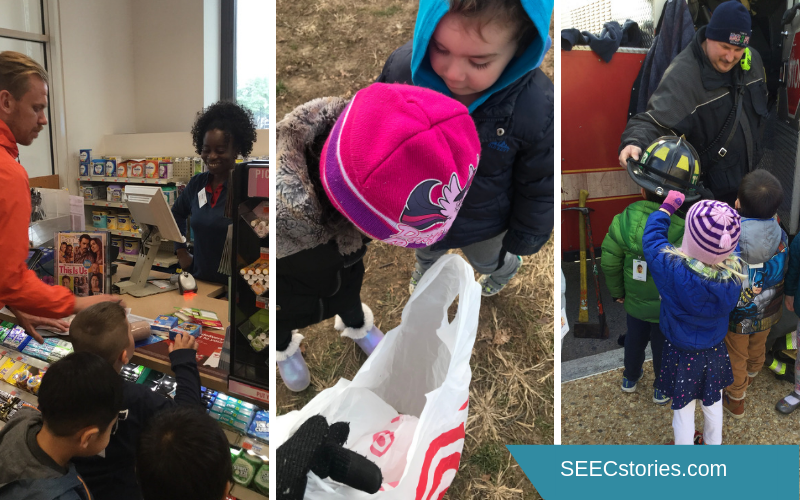Have you ever read about a place you really wanted to visit – a new restaurant or a faraway country? Have you ever been lucky enough to actually visit that place? How was the experience different from just reading about it? Once the sounds, smells, and sights flooded your senses – how did your understanding of that place change? Now imagine you are a young child with limited experience of the world. How do you think their understanding is enhanced when they get to experience the very thing they are learning about?
At SEEC, we believe that learning is richer and more meaningful when it is taken beyond the classroom and into the community. True we are fortunate enough to have access to a complex of museums, but we feel strongly that this type of learning can take place no matter where a school is located. Learning in the community not only deepens understanding, it also sparks interest, provides inspiration, broadens horizons, offers multiple and varied exposures, and cultivates a connection with the community.
Sparks Interest and Excitement and Provides Inspiration

You never know what you might find when you walk out of your classroom door and into the community. One of the benefits of learning outside the classroom is the unpredictability of what you will encounter. Just being outdoors sparks wonder and inspiration. Actually experiencing something with all your senses is more exciting, effective, and memorable than just hearing about it via a traditional didactic lesson.

While our classes generally have a destination in mind, they always take the time to explore when the children express interest in something. Educators can harness that interest to create learning experiences on-the-spot and back in the classroom. Children often become excited because they identify something related to what they are currently studying. For example, this preschool class had been learning about construction and happened to spot a cherry picker and safety equipment on their walk. These spontaneous sightings give the students autonomy over their own learning and broaden their understanding of a topic – all things that would not have happened if they had stayed in the classroom.
Connects Abstract Concepts to Concrete Examples

Young children think concretely, so it’s important to pair new ideas with tangible examples. After talking about wind in the classroom, one of our toddler classes went to blow bubbles and watch how the wind carried them away. After that, they held up a parachute to see how the wind moved it. Similarly, our kindergarten class had been learning about a severe type of wind storm called a haboob. Luckily, they were not caught in a haboob storm themselves, but did get caught outside on a particularly windy day and were able to appreciate the affects a strong wind in a whole new light.
Offers Multiple and Varied Exposures while Broadening Horizons

For young children, many of the concepts explored at school are completely new, without much background context. Going into the community allows children to gain multiple and varied exposures to the same concept, deepening their understanding and giving it a nuance they would not have from only one example. Last school year, our older infant class was interested in the bread they had at lunchtime. Their teachers took this opportunity to learn more about bread, how it is made and its many varieties. They went to the National Gallery of Art to see James Rosenquist’s White Bread, and to Paul Bakery where the chefs were gracious enough to give the children dough with which to play and demonstrate how they bake the bread.

Providing multiple and varied exposures also expands a child’s perspective of a topic. By going into the community children begin to see a world outside of themselves and their immediate surroundings. For example, when one of our preschool classes was learning about boats, they went to the National Museum of the American Indian to see a boat that was not as familiar to them, broadening their understanding of what a boat can be. They also went to the DC Marina where they encountered boats with which they were more familiar. They also had the chance to meet with a boat expert at one of the stores who helped them expand their knowledge of boats.
Cultivates a Connection with the Community and Fosters Citizenry

Children are growing up in a society in which the biggest challenges are not relegated to their community alone. Global warming, immigration, and diminishing natural resources, just to name a few, are global issues that will require the future generation to respect others and understand how humanity is interconnected. Learning in the community allows children to observe the impact of our actions and develop an appreciation for that which is different. It is also the place where children can see how we help each other and work together to solve our problems. For example, one of our preschool classes recently went to a local convenience store to replenish their first aid kit while another class helped to clean up litter on the National Mall. Inviting community members into the classroom is another way to have a positive impact on young children. Children can gain so much when they are able to interact with the very people who are responsible for cultivating and nurturing their community. These personal encounters also make students feel connected to the community as a citizen themselves.
Schools are in a variety of locales and settings, and getting out into the community can be challenging, however we strongly believe the benefits outweigh the drawbacks. Even a patch of grass right outside the classroom opens up immense opportunities for learning.
Join us for our upcoming workshop Learning Through Objects on March 14 & 15 to learn more about taking learning outside of the classroom and into the community!
